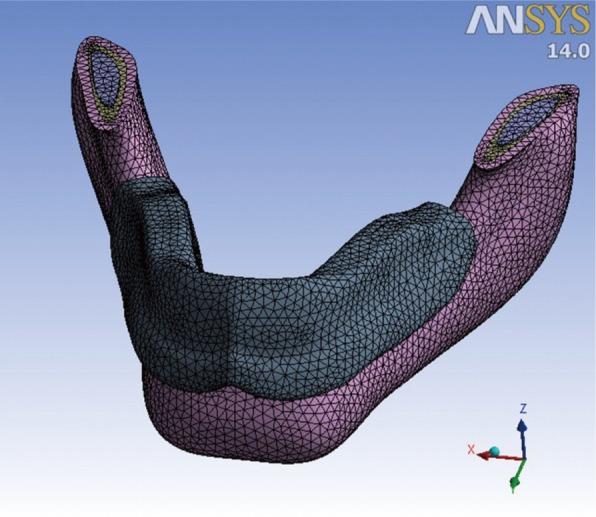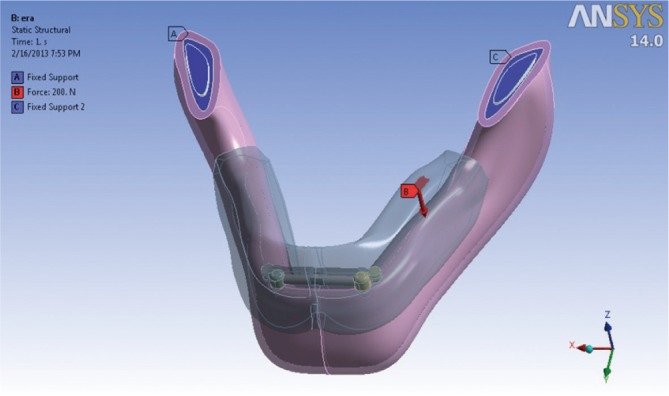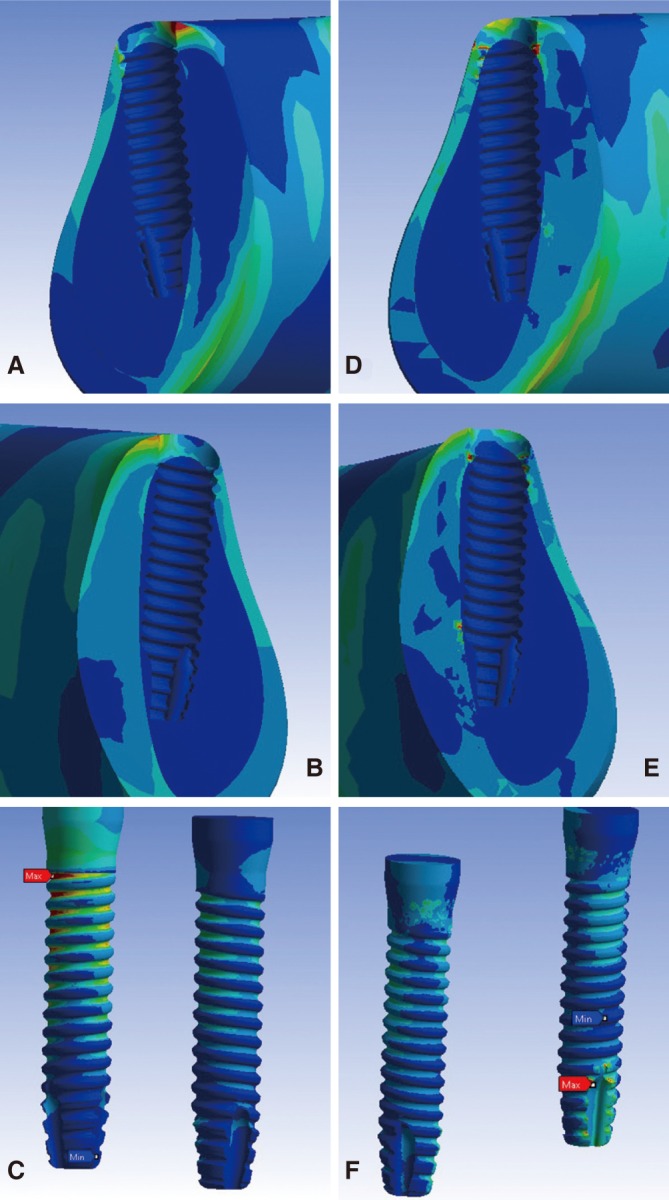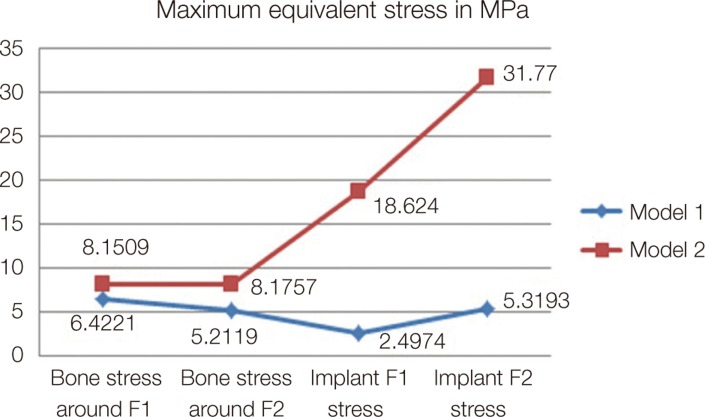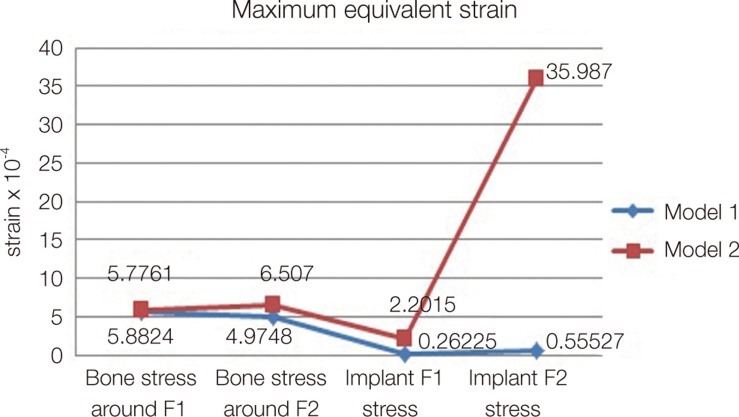J Adv Prosthodont.
2013 Aug;5(3):333-340. 10.4047/jap.2013.5.3.333.
Stress-strain distribution at bone-implant interface of two splinted overdenture systems using 3D finite element analysis
- Affiliations
-
- 1Prosthodontics, Prosthodontic Department, Faculty of Dentistry, Qassim University. Member, Dental Implant Committee, Dental Research Center Board Member, College of Dentistry, Qassim University, Qassim, Kingdom of Saudi Arabia. dr.mostafa.hussein@qudent.o
- KMID: 2118174
- DOI: http://doi.org/10.4047/jap.2013.5.3.333
Abstract
- PURPOSE
This study was accomplished to assess the biomechanical state of different retaining methods of bar implant-overdenture.
MATERIALS AND METHODS
Two 3D finite element models were designed. The first model included implant overdenture retained by Hader-clip attachment, while the second model included two extracoronal resilient attachment (ERA) studs added distally to Hader splint bar. A non-linear frictional contact type was assumed between overdentures and mucosa to represent sliding and rotational movements among different attachment components. A 200 N was applied at the molar region unilaterally and perpendicular to the occlusal plane. Additionally, the mandible was restrained at their ramus ends. The maximum equivalent stress and strain (von Mises) were recorded and analyzed at the bone-implant interface level.
RESULTS
The values of von Mises stress and strain of the first model at bone-implant interface were higher than their counterparts of the second model. Stress concentration and high value of strain were recognized surrounding implant of the unloaded side in both models.
CONCLUSION
There were different patterns of stress-strain distribution at bone-implant interface between the studied attachment designs. Hader bar-clip attachment showed better biomechanical behavior than adding ERA studs distal to hader bar.
Keyword
MeSH Terms
Figure
Reference
-
1. Misch CE. Dental implant prosthetics. St. Louis, Mo: Mosby;2005. p. 204–234.2. DeBoer J. Edentulous implants: overdenture versus fixed. J Prosthet Dent. 1993; 69:386–390. PMID: 8463968.
Article3. Sadowsky SJ, Caputo AA. Effect of anchorage systems and extension base contact on load transfer with mandibular implant-retained overdentures. J Prosthet Dent. 2000; 84:327–334. PMID: 11005906.
Article4. Cekiç C, Akça K, Cehreli MC. Effects of attachment design on strains around implants supporting overdentures. Quintessence Int. 2007; 38:e291–e297. PMID: 17625616.5. Celik G, Uludag B. Photoelastic stress analysis of various retention mechanisms on 3-implant-retained mandibular overdentures. J Prosthet Dent. 2007; 97:229–235. PMID: 17499093.
Article6. Fanuscu MI, Caputo AA. Influence of attachment systems on load transfer of an implant-assisted maxillary overdenture. J Prosthodont. 2004; 13:214–220. PMID: 15610541.
Article7. Wang HY, Zhang YM, Yao D, Chen JH. Effects of rigid and nonrigid extracoronal attachments on supporting tissues in extension base partial removable dental prostheses: a nonlinear finite element study. J Prosthet Dent. 2011; 105:338–346. PMID: 21530760.
Article8. Brewer AA, Morrow RM. Overdentures. 2nd ed. St. Louis: CV Mosby Co;1980.9. Tabata LF, Assunção WG, Barão VA, Gomes EA, Delben JA, de Sousa EA, Rocha EP. Comparison of single-standing or connected implants on stress distribution in bone of mandibular overdentures: a two-dimensional finite element analysis. J Craniofac Surg. 2010; 21:696–702. PMID: 20485031.10. Menicucci G, Lorenzetti M, Pera P, Preti G. Mandibular implant-retained overdenture: finite element analysis of two anchorage systems. Int J Oral Maxillofac Implants. 1998; 13:369–376. PMID: 9638007.11. Chun HJ, Park DN, Han CH, Heo SJ, Heo MS, Koak JY. Stress distributions in maxillary bone surrounding overdenture implants with different overdenture attachments. J Oral Rehabil. 2005; 32:193–205. PMID: 15707430.
Article12. Mericske-Stern R. Force distribution on implants supporting overdentures: the effect of distal bar extensions. A 3-D in vivo study. Clin Oral Implants Res. 1997; 8:142–151. PMID: 9758965.13. Tokuhisa M, Matsushita Y, Koyano K. In vitro study of a mandibular implant overdenture retained with ball, magnet, or bar attachments: comparison of load transfer and denture stability. Int J Prosthodont. 2003; 16:128–134. PMID: 12737242.14. Mariano LOH, Sartori EA, Broilo JR, Shinkai RSA, Corso L, Marczak RJ. Stresses in implant-supported overdentures with bone resorption: A 3-D finite element analysis. Rev Odonto Cienc. 2012; 27:41–46.
Article15. Ochiai KT, Williams BH, Hojo S, Nishimura R, Caputo AA. Photoelastic analysis of the effect of palatal support on various implant-supported overdenture designs. J Prosthet Dent. 2004; 91:421–427. PMID: 15153848.
Article16. Assunção WG, Gomes EA, Rocha EP, Delben JA. Three-dimensional finite element analysis of vertical and angular misfit in implant-supported fixed prostheses. Int J Oral Maxillofac Implants. 2011; 26:788–796. PMID: 21841989.17. van Staden RC, Guan H, Loo YC. Application of the finite element method in dental implant research. Comput Methods Biomech Biomed Engin. 2006; 9:257–270. PMID: 17132532.
Article18. Savadi RC, Agarwal J, Agarwal RS, Rangarajan V. Influence of Implant Surface Topography and Loading Condition on Stress Distribution in Bone Around Implants: A Comparative 3D FEA. J Indian Prosthodont Soc. 2011; 11:221–231. PMID: 23204731.
Article19. Prakash V, D'Souza M, Adhikari R. A comparison of stress distribution and flexion among various designs of bar attachments for implant overdentures: a three dimensional finite element analysis. Indian J Dent Res. 2009; 20:31–36. PMID: 19336857.
Article20. Tanino F, Hayakawa I, Hirano S, Minakuchi S. Finite element analysis of stress-breaking attachments on maxillary implant-retained overdentures. Int J Prosthodont. 2007; 20:193–198. PMID: 17455444.21. Bendjaballah MZ. The effect of non-contact conditions in a splinted fixed partial denture on the load sharing mechanism: a finite element study. J Bionic Eng. 2012; 9:336–342.
Article22. Barão VA, Assunção WG, Tabata LF, Delben JA, Gomes EA, de Sousa EA, Rocha EP. Finite element analysis to compare complete denture and implant-retained overdentures with different attachment systems. J Craniofac Surg. 2009; 20:1066–1071. PMID: 19553853.
Article23. Vafaei F, Khoshhal M, Bayat-Movahed S, Ahangary AH, Firooz F, Izady A, Rakhshan V. Comparative stress distribution of implant-retained mandibular ball-supported and bar-supported overlay dentures: a finite element analysis. J Oral Implantol. 2011; 37:421–429. PMID: 20712443.
Article24. Federick DR, Caputo AA. Effects of overdenture retention designs and implant orientations on load transfer characteristics. J Prosthet Dent. 1996; 76:624–632. PMID: 8957789.
Article25. Daas M, Dubois G, Bonnet AS, Lipinski P, Rignon-Bret C. A complete finite element model of a mandibular implant-retained overdenture with two implants: comparison between rigid and resilient attachment configurations. Med Eng Phys. 2008; 30:218–225. PMID: 17383925.
Article26. Liu J, Pan S, Dong J, Mo Z, Fan Y, Feng H. Influence of implant number on the biomechanical behaviour of mandibular implant-retained/supported overdentures: a three-dimensional finite element analysis. J Dent. 2013; 41:241–249. PMID: 23160036.
Article27. Osman RB, Elkhadem AH, Ma S, Swain MV. Finite element analysis of a novel implant distribution to support maxillary overdentures. Int J Oral Maxillofac Implants. 2013; 28:e1–e10. PMID: 23377076.
Article28. Misch CE. Contemporary Implant Dentistry. 3rd ed. St. Louis, Mo: Mosby;2008. p. 293–314.29. Chen IC, Brudvik JS, Mancl LA, Rubenstein JE, Chitswe K, Raigrodski AJ. Freedom of rotation of selected overdenture attachments: an in vitro study. J Prosthet Dent. 2011; 106:78–86. PMID: 21821161.
Article30. el-Sheikh AM, Hobkirk JA. Force transmission in bar-retained implant-stabilised mandibular over-dentures: an in-vitro study. Eur J Prosthodont Restor Dent. 2002; 10:173–178. PMID: 12526275.31. Bergendal T, Engquist B. Implant-supported overdentures: a longitudinal prospective study. Int J Oral Maxillofac Implants. 1998; 13:253–262. PMID: 9581412.32. Ueda T, Kremer U, Katsoulis J, Mericske-Stern R. Long-term results of mandibular implants supporting an overdenture: implant survival, failures, and crestal bone level changes. Int J Oral Maxillofac Implants. 2011; 26:365–372. PMID: 21483890.33. Rismanchian M, Dakhilalian M, Bajoghli F, Ghasemi E, Sadr-Eshkevari P. Implant-retained mandibular bar-supported overlay dentures: a finite element stress analysis of four different bar heights. J Oral Implantol. 2012; 38:133–139. PMID: 20545552.
Article34. Preiskel HW. Precision attachments in prosthodontics: The applications of intracoronal and extracoronal attachments. 1st ed. Chicago: Quintessence Pub. Co.;1984.35. Takayama Y, Yamada T, Araki O, Seki T, Kawasaki T. The dynamic behaviour of a lower complete denture during unilateral loads: analysis using the finite element method. J Oral Rehabil. 2001; 28:1064–1074. PMID: 11722724.
Article36. Davidovits P. Physics in biology and medicine. 3rd ed. Academic Press;2007.37. Rismanchian M, Dakhilalian M, Bajoghli F, Ghasemi E, Sadr-Eshkevari P. Implant-retained mandibular bar-supported overlay dentures: a finite element stress analysis of four different bar heights. J Oral Implantol. 2012; 38:133–139. PMID: 20545552.
Article38. Merdji A, Bouiadjra BB, Chikh BO, Mootanah R, Aminallah L, Serier B, Muslih IM. Stress distribution in dental prosthesis under an occlusal combined dynamic loading. Mater Des. 2012; 36:705–713.
Article
- Full Text Links
- Actions
-
Cited
- CITED
-
- Close
- Share
- Similar articles
-
- Finite Element Analysis of Stress Distribution on Telescopic System for Mandibular Implant Supported Overdenture
- Effect of attachments and palatal coverage of maxillary implant overdenture on stress distribution: a finite element analysis
- Finite element analysis of the effect of cantilever and implant orientation on stress distribution in a mandibular implant-supported bar overdenture
- Finite element stress analysis of maxillary two implants-retained overdenture according go position of implant fixtures
- THREE DIMENSIONAL FINITE ELEMENT ANALYSIS ON THE MINMUM CONTACT FRACTION OF BONE-IMPLANT INTERFACE


